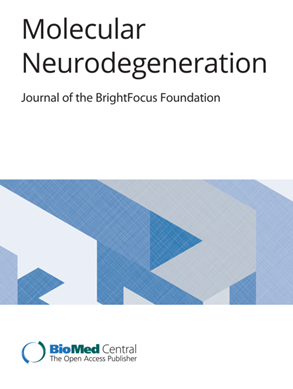可溶性环氧化物水解酶的抑制赋予神经保护和恢复小胶质细胞稳态的牛头病小鼠模型
IF 17.5
1区 医学
Q1 NEUROSCIENCES
引用次数: 0
摘要
环氧二十碳三烯酸(EETs)是花生四烯酸代谢的衍生物,具有抗炎活性。然而,由于可溶性环氧化物水解酶(sEH)的快速水解,它们的功效受到了限制。在阿尔茨海默病(AD)的 Aβ 小鼠模型中,抑制 sEH 可稳定 EETs 并减轻神经炎症。然而,人们对 sEH-EET 信号通路在其他中枢神经系统细胞类型和神经退行性疾病中的作用了解较少。在这里,我们用小分子 sEH 抑制剂 TPPU 处理 PS19 小鼠,并将 PS19 小鼠与 Ephx2(编码 sEH 的基因)基因敲除小鼠杂交,研究了 sEH-EET 轴在 tauopathy 中的机制和功能作用。随后进行了单核 RNA 序列分析(snRNA-seq)、生化和免疫组化分析以及行为评估。此外,我们还研究了sEH-EET通路对原代小胶质细胞培养物和人类诱导多能干细胞(iPSC)衍生神经元的影响,这些神经元表现出播种诱导的Tau包涵体。 snRNA-seq显示,TPPU处理可上调参与肌动蛋白细胞骨架和兴奋性突触通路的基因。用TPPU处理人iPSC衍生神经元可提高突触密度,而不影响Tau的积累,这表明sEH阻断具有细胞自主神经保护作用。此外,抑制 sEH 可逆转 PS19 小鼠的疾病相关和干扰素反应性小胶质细胞状态,而补充 EET 则可促进原代小胶质细胞培养物中 Tau 的吞噬和清除。这些研究结果表明,sEH阻断或EET增强可同时靶向神经元和小胶质细胞通路,从而对神经退行性tau病症产生疗效。本文章由计算机程序翻译,如有差异,请以英文原文为准。
Inhibition of soluble epoxide hydrolase confers neuroprotection and restores microglial homeostasis in a tauopathy mouse model
The epoxyeicosatrienoic acids (EETs) are derivatives of the arachidonic acid metabolism with anti-inflammatory activities. However, their efficacy is limited due to the rapid hydrolysis by soluble epoxide hydrolase (sEH). Inhibition of sEH has been shown to stabilize the EETs and reduce neuroinflammation in Aβ mouse models of Alzheimer’s disease (AD). However, the role of the sEH-EET signaling pathway in other CNS cell types and neurodegenerative conditions are less understood. Here we investigated the mechanisms and functional role of the sEH-EET axis in tauopathy by treating PS19 mice with a small molecule sEH inhibitor TPPU and by crossing the PS19 mice with Ephx2 (gene encoding sEH) knockout mice. This was followed by single-nucleus RNA-sequencing (snRNA-seq), biochemical and immunohistochemical analysis, and behavioral assessments. Additionally, we examined the effects of the sEH-EET pathway in primary microglia cultures and human induced pluripotent stem cell (iPSC)-derived neurons exhibiting seeding-induced Tau inclusions. sEH inhibition improved cognitive function, rescued neuronal cell loss, and reduced Tau pathology and microglial reactivity. snRNA-seq revealed that TPPU treatment upregulated genes involved in actin cytoskeleton and excitatory synaptic pathways. Treatment of human iPSC-derived neurons with TPPU enhanced synaptic density without affecting Tau accumulation, suggesting a cell-autonomous neuroprotective effect of sEH blockade. Furthermore, sEH inhibition reversed disease-associated and interferon-responsive microglial states in PS19 mice, while EET supplementation promoted Tau phagocytosis and clearance in primary microglia cultures. These findings demonstrate that sEH blockade or EET augmentation confers therapeutic benefit in neurodegenerative tauopathies by simultaneously targeting neuronal and microglial pathways.
求助全文
通过发布文献求助,成功后即可免费获取论文全文。
去求助
来源期刊

Molecular Neurodegeneration
医学-神经科学
CiteScore
23.00
自引率
4.60%
发文量
78
审稿时长
6-12 weeks
期刊介绍:
Molecular Neurodegeneration, an open-access, peer-reviewed journal, comprehensively covers neurodegeneration research at the molecular and cellular levels.
Neurodegenerative diseases, such as Alzheimer's, Parkinson's, Huntington's, and prion diseases, fall under its purview. These disorders, often linked to advanced aging and characterized by varying degrees of dementia, pose a significant public health concern with the growing aging population. Recent strides in understanding the molecular and cellular mechanisms of these neurodegenerative disorders offer valuable insights into their pathogenesis.
 求助内容:
求助内容: 应助结果提醒方式:
应助结果提醒方式:


